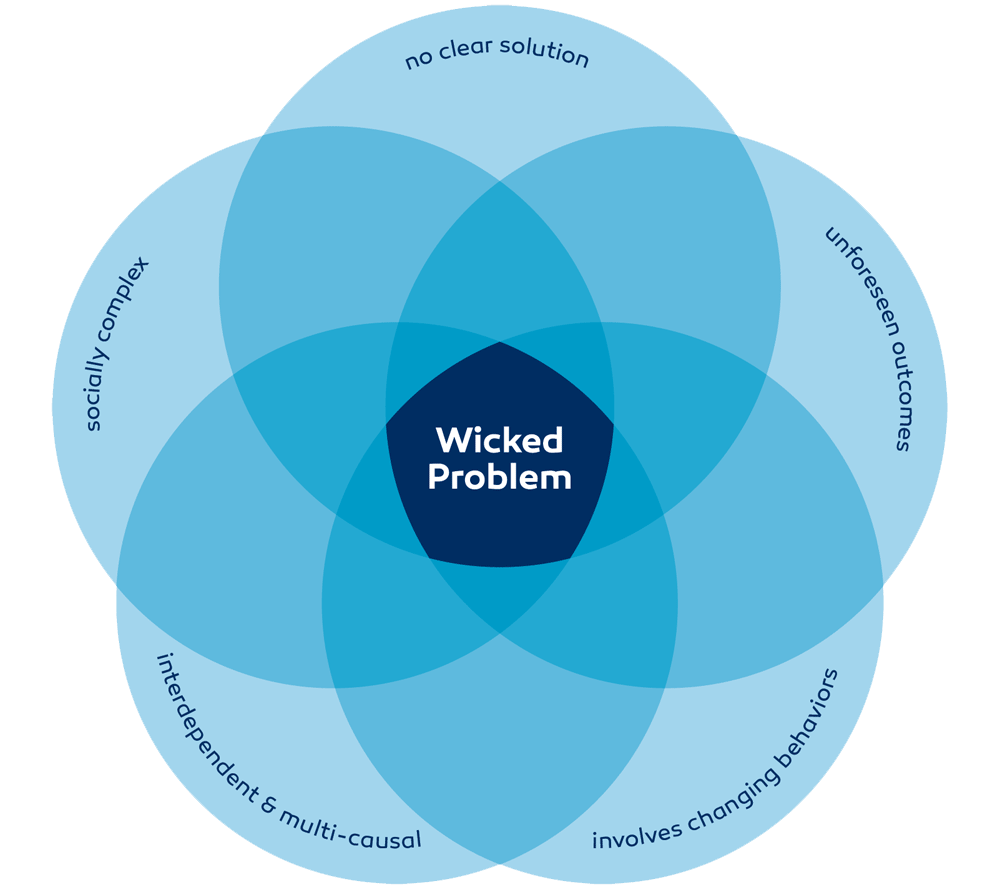Many businesses today desperately want – and need – to become more Innovative, Agile, and Creative, but they simply don’t know how.
Companies continue to do business the same way for the past 200 years since the beginning of the industrial revolution. They focus on making incremental improvements to products and services while using the same old business methods to differentiate and remain competitive, e.g. cost cutting, layoffs, M&A, etc.

It’s the definition of insanity, where businesses continue to do the same things and expect better results. Sears wasted $6 BILLION attempting to avoid bankruptcy by doing a share buyback. Sears executives knew for almost 10 years that they needed to change and did nothing new to innovate or compete.
It’s time for organizations to embrace a new way of thinking, innovating, and solving “wicked problems”…
DESIGN THINKING IS THE EXTRAORDINARY CATALYST FOR INNOVATION AND TRANSFORMATION
Design Thinking is an approach used for creative problem-solving, and originated from the methods and processes that designers use (hence the name). It evolved from myriad fields — including architecture, engineering and business — but can also be applied to any industry, organization, team, and to almost any problem.

“Design thinking is a human-centered approach to innovation that draws from the designer’s toolkit to integrate the needs of people, the possibilities of technology, and the requirements for business success.”
— Tim Brown, CEO of IDEO
It’s especially useful when solving “wicked problems,” or extremely complex problems that are highly ambiguous in nature with many unknown factors and no definitive solution. In fact, solving one aspect of a wicked problem is likely to produce more challenges. Additionally, wicked problems have no stopping point; as the nature of the problem changes over time, so must the solution.
Solving wicked problems is therefore an ongoing process that requires Design Thinking! Some examples of wicked problems in our society today include things like poverty, hunger, and climate change.

Design Thinking is known as the healthy middle ground of problem-solving — it’s not totally anchored in emotion and intuition, nor does it rely solely on analytics, science and rationale; it uses a combination of both.
It’s an extraordinary catalyst for innovation and transformation because it leads us on the quest to explore and embrace new, unique, and often unpredictable points of view.
PRINCIPLES OF DESIGN THINKING
Design Principles are first principles that serve as the design foundation for a project in the form of design recommendations that guide each design decision your design team makes as they’re working on a design project – providing the necessary focus to create a kick*ss aesthetic and experience that’s consistent throughout the product that your users will absolutely love.
And of course Design Thinking has its own set of principles…
- Human-Centered Design: No matter what the context, all design activity is social in nature, and any social innovation will bring us back to the “human-centric point of view.”
- Embrace Ambiguity: Ambiguity is inevitable, and it cannot be removed or oversimplified. Experimenting at the limits of your knowledge and ability is crucial in being able to see things differently.
- Iterative Approach: All design is redesign. While technology and social circumstances may change and evolve, basic human needs remain unchanged. We essentially only redesign the means of fulfilling these needs or reaching desired outcomes.
- Visually Tactile: Making ideas visual and tangible in the form of prototypes enables teams to communicate and develop them more effectively.
THE DESIGN THINKING PROCESS
Design Thinking is an iterative process — typically involving 5 to 7 steps — that leads to the effective development of products, services, and solutions that will be adopted by the target audience.
However, utilizing Design Thinking is almost never a linear path, it’s an iterative approach that requires you to constantly rethink, experiment, test, fail fast, and optimize a solution until you’ve developed a concept that is valuable and meaningful in the eyes of your target audience.

Design Thinking relies on the human ability to be intuitive, to recognize patterns, and to construct ideas that are emotionally meaningful as well as functional. I recommend that you try it once, and then adapt it to suit your particular team and/or organizational needs.
DESIGN THINKING ENABLES NEW ORGANIZATIONAL COMPETENCIES
Many organizations buy into the myth that Design Thinking is a one time approach to solve problems and innovate. And they’re partly right. But if you apply Design Thinking broadly and continuously in your organization, you’ll develop and refine new competencies that will enable your organization to become extremely adept at being creative and innovative.
Doing so will enable these competencies in any/all departments in your organization…
#1: THINKING DIFFERENT
Design Thinking helps with the very foundation of creativity and innovation, which is the process of questioning. Design Thinking will enable your team to develop the right set of questions, ensuring that you’re properly framing your questions so that you can adequately question the problem, the underlying assumptions, and the implications.

#2: EMPATHIZING WITH USERS
Design Thinking revolves around a deep interest in developing an understanding of the people for whom you’re designing the products or services. To gain this insight, I recommend that you take an ethnographic approach and immerse your team in your customers’/users’ experience and even lifestyle on a frequent basis, thereby continuously gaining deeper understanding and uncovering unarticulated needs.

Simply put, developing an empathy competency allows an organization to understand target users better, regardless of whether those users are employees, customers, and/or partners. And that is the critical foundation for your design & development process, and a key factor for determining success with products & services.
#3: SOLVING COMPLEX PROBLEMS
Design Thinking is extremely powerful for tackling problems that are ill-defined or unknown. Especially when all other approaches fail, Design Thinking is the right approach to use as the starting point to fully re-frame the problem in human-centric ways.
 Doing so continuously will enable your organization to quickly solve complex problems in a dynamic environment.
Doing so continuously will enable your organization to quickly solve complex problems in a dynamic environment.
#4: EXPERIMENTATION
Design Thinking can enable ongoing experimentation: sketching, prototyping, testing, and trying out concepts and ideas. It allows you to rapidly create many ideas in brainstorming sessions, and adopt a hands-on approach in prototyping and testing concepts with your target audience.

#5: COLLABORATION

Design Thinking enables effective collaboration because it focuses on developing unique solutions; this requires engagement from a diverse, cross-functional team in order to fully understand the scope of a problem from all angles. And conversely, developing a solution in isolation may make it too narrowly focused or even unpractical.
“The focus on possibilities, rather than on the constraints imposed by the status quo, helps diverse teams have more-collaborative and creative discussions about the design criteria, or the set of key features that an ideal innovation should have. Establishing a spirit of inquiry deepens dissatisfaction with the status quo and makes it easier for teams to reach consensus throughout the innovation process.”
– Jeanne Liedtka, Design Thinking expert and professor at the University of Virginia’s Darden School of Business
#6: INNOVATION / R&D
Design Thinking helps provide the necessary structure to the innovation process. Innovation without guardrails can be costly and prone to risk. By utilizing a proven approach to collaboration, creativity, and problem-solving, organizations can stay focused and aligned on developing the right solutions for their customers.
“And by supplying a structure to the innovation process, design thinking helps innovators collaborate and agree on what is essential to the outcome at every phase. It does this not only by overcoming workplace politics but by shaping the experiences of the innovators, and of their key stakeholders and implementers, at every step.”
– Jeanne Liedtka, Design Thinking expert and professor at the University of Virginia’s Darden School of Business
CONCLUSION
I’ve found Design Thinking extremely powerful catalyst for my teams and companies because we’re able to look at our products, services, and experiences differently when we can think like our customers. And this provides us with new opportunities to solve problems and overcome challenges that otherwise may be impossible to solve. Many companies like Apple, Google, and Airbnb are utilizing Design Thinking because it enables them to break out of their old thinking in order to find new ways to innovate and ideate new products, services, and experiences.

Maintaining this customer mindset is a priority – even when your company is doing well – because it helps track the evolving needs and wants of your customers and the broader market, which helps you offer new products and services that add meaningful value for them. The bottom line is if your organization is not keeping up with the changing needs and wants of your customers, someone else will.



One thought on “The Power of Design Thinking Enables New Organizational Competencies”